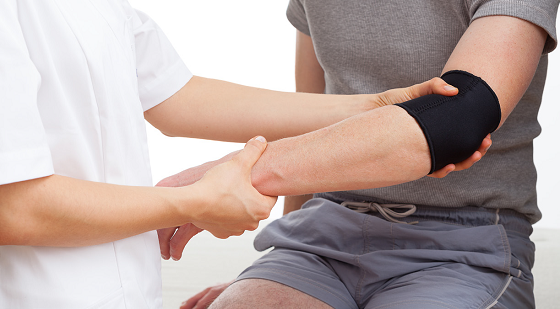Latest News & Blog
Peter Brownson gives advice for common shoulder and elbow injuries in tennis
Tennis is classically associated with the development of a tennis elbow syndrome (lateral epicondylitis). However, it sho uld be noted that the condition is very common in individuals in their middle years and is in no way restricted to those playing tennis.
The condition is caused by inflammation in the forearm extensor muscles where they attach to the outside of the elbow. Those affected will experience pain with manual activities in general and, as the forearm muscles are contracted when gripping a racquet, tennis players will experience pain when playing. They will notice it most prominently when playing a backhand, when the extensor muscles are contracting hardest.
The condition tends to run two courses, either a mild course lasting up to six months or a more prolonged course of one to two years. The condition will resolve spontaneously in the vast majority of individuals and, as such, it is typically managed symptomatically. Ice, rest and physiotherapy input will be helpful. Some individuals find fitting a clasp beneficial as well as applying topical, non-steroidal anti-inflammatory gels.
Tennis players are advised to check that their grip is the correct size. In addition, playing with a larger headed racquet with a larger sweet spot may be helpful as this may reducing the string tension slightly (although, over reduction should be avoided as this tends to encourage the player to hit the ball harder and is counter-productive.)
If symptoms are intrusive then injection treatment may be appropriate. There are a number of different types of injection treatment advocated. Currently, there is a trend towards an injection using the patient’s own blood. The theory is that part of the blood (the platelets) contains growth factors which promote healing. In its most basic form, the injection may take the form of dry needling in and around the tendon origin to promote a small amount of bleeding. There are more complex techniques available including the use of Platelet-Rich Plasma (PRP) injections. PRP injections involve taking a small amount of the patients own blood, spinning it down in a centrifuge and then taking the portion of the blood containing the platelets and growth factors and re-injecting these in and around the tendon origin.
Shoulder pain is also relatively common in tennis players. The most common complaint is of
impingement pain which occurs when taking the arm into an overhead position, as when carrying out a serve or overhead smash.

Impingement pain is relatively common in individuals in their middle years. The condition is caused by degenerative changes within some of the rotator cuff tendons in the shoulder. In its early stages the condition is managed by physiotherapy. If symptoms become intrusive then an injection can be very helpful in alleviating symptoms whilst in the longer term, if symptoms persist, it is possible to carry out a day case key hole procedure (a subacromial decompression) to relieve the problem. The operation carries an 85% success rate and patients are usually free to use their arm the day following surgery.


